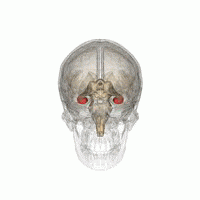Where are we now?
By ucwehpi, on 10 November 2015
Mark Peter Wright and Helena Hunter were chosen to work with curators and academic researchers from UCL on this new exhibition project. Mark is an artist and researcher working across sound, video, assemblage and performance and Helena’s practice spans performance, text and moving image. In this series of blogs running from now until the exhibition opens, the two will discuss how they are finding the process of research and discuss the ideas that are emerging. The blog will stand in as the space of thinking for the exhibition
Helen Pike – Public Programmer
‘The fossils of the future are the ones we live among’.
Jussi Parikka, A Geology of Media, 2015, p.123
By Helena Hunter and Mark Peter Wright
As part of our research for the forthcoming Octagon exhibition we visited neuroscientists Aman Saleem and Matteo Carandini and at The Institute of Ophthalmology. We were introduced to methods and practices from their research that focused upon navigation and cognitive mapping. The main content of our discussions centred upon the ‘hippocampus’ – a region deep within the brain that resembles a seahorse. It plays a vital role in how both humans and mammals navigate through space, in addition to both short and long term memory function. As a multi-sensual area of the brain it differs from the visual cortex that has a more singular visual pursuit, offering a reception for sensory input that gives recognition but not clarity as to what we are seeing. The hippocampus is a plural, multi-sensory region in the brain accommodating a dualistic appreciation of place: the point we are physically located in and the place we may be relating to at a distance. Like the blue dot on Google maps, it resembles a pulsing area where the process and production of where we are, or think we are in the present is activated.
But where are we now? [1] This deceptively simple question has opened up many trajectories for us. Where are we in terms of physical space? Political or ecological contexts? Subjective and collective identities? What happens between the here and there when binaries collapse? What errors, frictions and fictions may emerge?
[1] This deceptively simple question has opened up many trajectories for us. Where are we in terms of physical space? Political or ecological contexts? Subjective and collective identities? What happens between the here and there when binaries collapse? What errors, frictions and fictions may emerge?
The Anthropocence is the current condition that underwrites such broad questioning of ‘where are we now?’ The term, coined by scientists, marks out a new geological epoch. It is an umbrella within which to describe how the human (antropos) has become irrecoverably grafted into every aspect of global-techno-animal life. Its consequences are read primarily through the current climate and ecological crisis. It also speaks towards the impact of advanced capitalism and our relationship to non-human agents – from animals to rocks. It is debated that we have been in this “now” since the industrial revolution, perhaps even further back. (See: Parikka, 2015). Alternative hybrid formations of the term, pinning specific areas of inquiry, have also been proposed (See: Braidotti ‘Capitaloscene’; Haraway ‘Chthulucene’; Parikka ‘Anthrobscene’).
[1] We are reluctant to speak of a “we” in terms of one homogenised collection of (human) people. When “we” is evoked we are therefore talking from our subjective and relational positions firstly, but also wish to extend a sense of collectivity and agency to non-human others.
 Close
Close

